Chapter Four
Law and Disorder Under Louis-Philippe
In July 1830 the ministers of Charles X issued four ordinances intended to stifle freedom of the press and break legislative opposition to the crown. This unpopular action inflamed the liberal opposition that had gained an unlikely ally in Chateaubriand, who, soured by his loss of the Ministry of Foreign Affairs in 1824 and reborn as an outspoken opponent of press censorship, was scandalized by the ordinances, which presumed, in an Old Regime spirit (comme au temps du bon plaisir), that the king's authority superseded the law.[1]
Popular indignation over the four ordinances fueled a successful uprising that demonstrated the tenacious vitality of the principle inaugurated with the Constitution of 1791 that "in France no authority is superior to the law." With the cry "Long live the charter!" the elder branch of the Bourbon dynasty was driven from the French throne and the Charter of 1814 revised. No longer would the king have blanket authority, granted by article 14 of the Bourbon charter, to make "the regulations and ordinances necessary for the . . . security of the state."[2] And the monarch would never have the power "to either suspend the laws themselves or dispense with their execution" (Charter of 1830, art. 13).
Duke Louis-Philippe d'Orleans, lieutenant general of France and head of the younger branch of the French royal family, was elevated to the throne to protect the constitutional principles Charles X's ministers had disregarded. The new monarch's relationship to the Bourbon dynasty was complicated because his
This chapter is an expanded and revised version of the article "Henri de Triqueti, Auguste Préault, and the Glorification of Law under the July Monarchy," Art Bulletin , LXX, September 1988, pp. 486-501.
father, who had sported the name Philippe-Egalité during the Revolution, had voted for the death of Louis XVI. Louis-Philippe's distant blood kinship with his deposed predecessor did not guarantee his mandate to rule. Legal probity, symbolized by the inaugural oath of allegiance to the new constitutional Charter of 1830, invested the new king with authority; he acknowledged as much by insisting on legal rectitude in the daily business of government. François Guizot, one of Louis-Philippe's most loyal ministers, said that this Citizen King "made legal rule the basis of his domestic policy; he never asked his counselors to circumvent the law; he would have reminded them of [the law] himself if the occasion [for circumvention] had arisen, immediately observing, 'It's the law'—no matter how disagreeable or embarrassing it was to him."[3]
An unofficial bronze commemorative medal by Joseph-Arnold Pingret (1798-1862) expressed the idea that the revolution of 1830 had reestablished the law (Figs. 37, 38). The inscription NATIONAL LIBERTY RECONQUERED BY THE PEOPLE, JULY 27, 28, 29, 1830 encircles a laurel-crowned Liberty—a well-groomed Olympian cousin of Delacroix's famous heroine of the barricades—superimposed on the fasces of unity. The anti-clericalism of the inscription on the reverse reflects a decade and a half of oppressive Bourbon piety: TRIUMPH OF TRUTH OVER JESUITISM . An emblematic panoply honoring the reestablishment of the constitutional covenant includes the scales of justice, the mirror and serpent of prudence, and a Mosaic tablet inscribed REIGN OF THE LAWS .
Pingret's representation of the law as roundheaded tablets recalls any number of revolutionary images of the constitution and of the Declaration of the Rights of Man and Citizen; the revival of this revolutionary iconographic tradition under the July Monarchy was appropriate to the regime's professed veneration of the law. Nonetheless, the perception of the law was different from what it had been during the Revolution of 1789. Under Louis-Philippe, the law was not a miraculous source of national regeneration but a shield defending order and property. Thus Guizot said that Louis-Philippe considered the law "the best shield for the throne as well as for the citizenry."[4]
This conception of the law developed from the dangers faced by the regime. It became apparent at the outset of Louis-Philippe's reign that the regime represented the interests of the prosperous middle class and sympathized with neither the egalitarian sentiment nor the bellicose nationalism of those who had brought down the Bourbon Restoration. The July Monarchy was menaced in its early
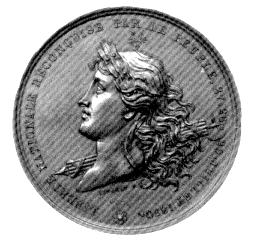
Fig. 37.
J.-A. Pingret, medal commemorating
the July Revolution (obverse). Cabinet
des Médailles, Bibliothèque Nationale, Paris.
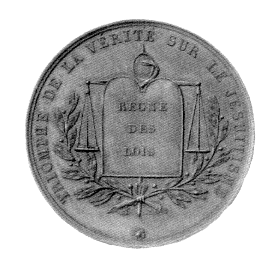
Fig. 38
J.-A. Pingret, medal commemorating
the July Revolution (reverse). Cabinet
des Médailles, Bibliothèque Nationale, Paris.
years from both the legitimist (pro-Bourbon) Right and the republican Left. An illiberal policy toward the regime's enemies was firmly established by Casimir Périer, president of the Council of Royal Ministers and minister of the interior from March 13, 1831, until his death on May 16, 1832. As the leader of Louis-Philippe's government, Périer professed a "cult of the law,"[5] whose severity is evident in an address to the Chamber of Deputies following the repression of an uprising in Lyon in 1831: "It is necessary to teach people who lay claim to the honor of being free that liberty is the despotism of the law." (From the audience, in response, came cries of "Bravo! Very Good!")[6]
Similar in its defensive spirit is a painting in grisaille by François-Edouard Picot (1786-1868), July 1830: France Defends the Charter (Fig. 39), commissioned for the ceiling of the Hall of 1830 in the Palace of Versailles.[7] Here the revolutionary roundheaded tablets of law are reborn as the Charter of 1830, and protected from blind royalist absolutism and masked republicanism. The Hall of 1830 was part of the historical museum Louis-Philippe created in the Palace of Versailles to glorify the history of France and to legitimize his own regime. The brash literal character
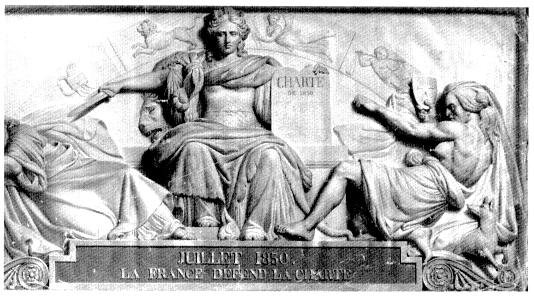
Fig. 39.
F.-E. Picot, July 1830: France Defends the Charter , 1835. Paris, Louvre.
of Picot's allegory suited the propagandistic function of the room for which it was commissioned.
The July Monarchy's cult of the law was expressed most elaborately in the decoration of the Palais-Bourbon. In 1828-33 Jean-Baptiste-Jules de Joly (1788-1865), who succeeded Bernard Poyet as the architect responsible for the legislative palace, directed the alteration and enlargement of the building.[8] Joly remodeled the assembly hall, added a library, and designed a symmetrical suite of ceremonial rooms appropriate to the nation's premier legislative body (Fig. 40).
At the opening of the annual legislative session, Louis-Philippe would go to the Palais-Bourbon to deliver the "Speech from the Throne" to the legislature. He would enter the palace not through the great Napoleonic portico on the Seine but via the Court of Honor on the Rue de l'Université. A contemporary print shows him mounting the palace steps at the head of a vast retinue (Fig. 41). As he entered the palace via the new Salle Louis-Philippe (Fig. 42; G on plan), he would see his own colossal effigy, swearing fidelity to the constitutional charter, in a richly coffered barrel-vaulted gallery, where statues of four modern French legislators
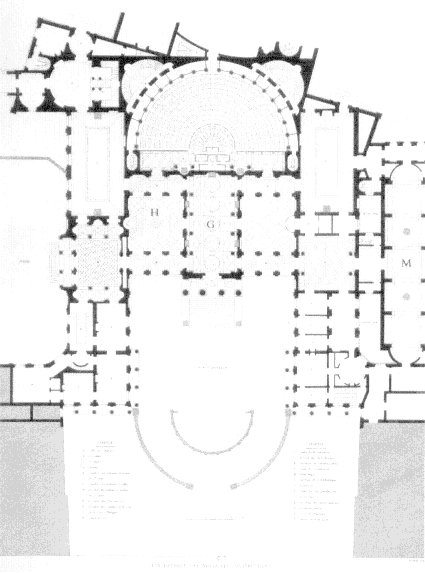
Fig. 40.
Plan of the Palais-Bourbon, from J. de Joly, Plans, coupes, élévations
et détails de la restauration de la Chambre des Députés , Paris, 1840, plate 3.
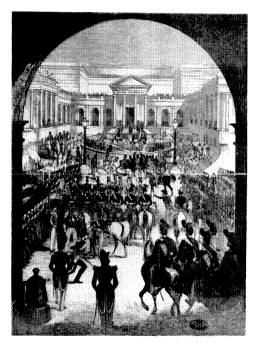
Fig. 41.
Arrival of the King at the Palais-Bourbon ,
1843. Bibliothèque Nationale, Paris.
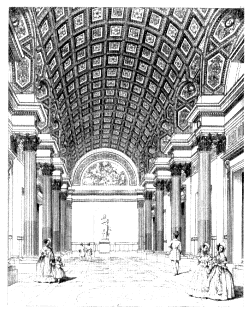
Fig. 42.
Salle Louis-Philippe, Palais-Bourbon, Paris, from
J. de Joly, Plans, coupes, élévations et détails
de la restauration de la Chambre des Députés,
Paris, 1840, plate 29.
still stand in niches between freestanding Corinthian columns.[9] At either end of the Salle Louis-Philippe two large marble relief sculptures by Baron Henri-Joseph-François de Triqueti (1804-1874) celebrate the divine nature of law and its benefits to society (Figs. 43, 44).[10]
Protecting Law (La Loi protectrice ) and Avenging Law (La Loi vengeresse ) are semicircular compositions of life-size figures capped by Mosaic tablets inscribed LEX (Law). In Protecting Law , facing the entrance to the Salle Louis-Philippe, the tablets of the law are set in a panoply that features the caduceus of commerce and a hand of justice. To the left, a rustic family sleeps amid the tools and fruit of its labor under the protection of an armed woman. To the right, a book is inscribed by an infant-bearing mother to show the emanation of the law from the will of its beneficiaries (cf. Fig. 13, the revolutionary print The French Constitution , where
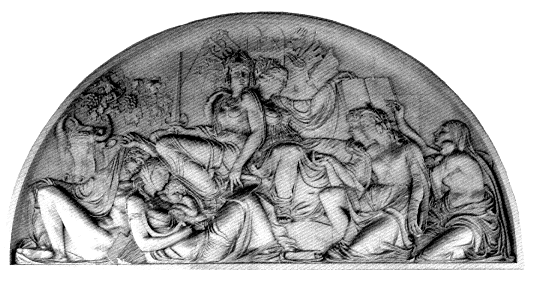
Fig. 43.
H. de Triqueti, Protecting Law , 1833-34. Salle Casimir-Périer
(formerly called Salle Louis-Philippe), Palais-Bourbon, Paris.
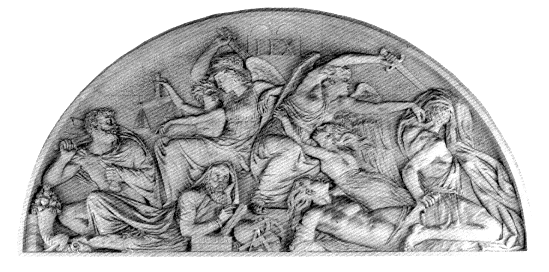
Fig. 44.
H. de Triqueti, Avenging Law, 1833-34. Salle Casimir-Périer, Palais-Bourbon, Paris.
the Nation inscribes the tablets of the law with the scepter of legislative power). A young couple clasping hands represents the covenant of marriage, revered as a fundamental cohesive element of society by the drafters of the Code Napoléon.[11]Protecting Law thus raises the law in triumph over fundamental human bonds: marriage, family, and labor.
Avenging Law , above the entrance, shows the nurturing of civilization under the fierce guardianship of the law. A philosopher resembling Socrates, protected by two winged figures, reclines beside attributes of industry, the arts, and science.[12] At either end of the lunette, perpetrators of murder and theft are apprehended. Whereas Protecting Law has a uniform relief and smooth ground, Avenging Law has a more irregular pattern and a rough ground that subtly dramatizes the theme of crime and punishment.
In the collection of the Ecole des Beaux-Arts is a pair of studies for Protecting Law and Avenging Law , each inscribed "présenté," that were apparently submitted to the ministry for approval (Figs. 45, 46). The firm and meticulous contour of the study for Protecting Law contrasts with the nervous vitality of that for Avenging Law ; this contrast echoes the thematic counterpoint of the two lunettes more emphatically than do differences in ground texture and relief pattern in the finished marbles. Otherwise, the relief sculptures remained faithful to the drawings where, in the language of official allegory, homage is rendered to the entities the July Monarchy held scared: law, property, public order, agriculture, industry, and commerce. In these works, the revolutionary association of the law with regeneration and natural rights has been replaced by reference to material prosperity, punishment, and protection.
The pious glorification of the law in Triqueti's Protecting Law resembles that of "Les Laboureurs," a section of Lamartine's book-length poem Jocelyn (1836), written in the fall of 1835. Describing a scene of agricultural labor and rest, the poet sees a reflection of divine law in the earthly law of labor and the bond of familial love:
Ô travail, sainte loi du monde,
Ton mystère va s'accomplir;
Pour rendre la glèbe féconde,
De sueur il faut l'amollir!
. . . . . . . . . . . . . . . . . . . .
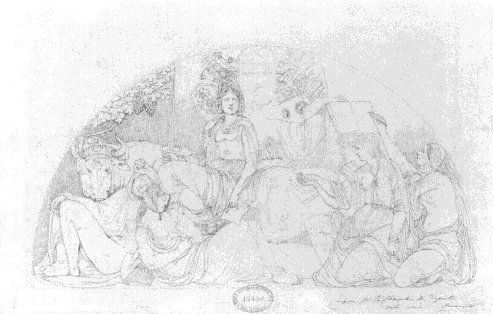
Fig. 45.
H. de Triqueti, study for Protecting Law , 1833.
Ecole Nationale Supérieure des Beaux-Arts, Paris.
Et pour consacrer l'héritage
Du champ labouré par leurs mains,
Les bornes firent le partage
De la terre entre les humains,
Et l'homme, à tousles droits propice,
Trouva dans son coeur la justice
Et grava son code en tout lieu,
Et pour consacrer ses lois même,
S'élevant à la loi suprême,
Chercha la juge et trouva Dieu!
. . . . . . . . . . . . . . . . . . . .
Oh! dormez sous le vert nuage
De feuilles qui couvrent ce hid,
Homme, femme, enfants leur image,
Que la loi d'amour réunit!
Ô famille, abrégé du monde,
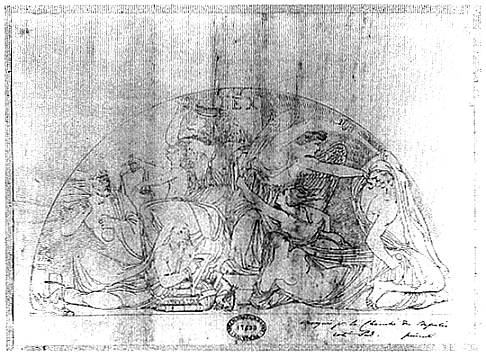
Fig. 46 (opposite).
H. de Triqueti, study for Avenging Law , 1833. Ecole Nationale Supérieure des Beaux-Arts, Paris.
Instinct qui charme et qui féonde
Les ills de l'homme en ce bas lieu,
N'est-ce pas toi qui nous rappelle
Cette parenté fraternelle
Des enfants dont le père est Dieu?
Oh work, sacred law of the world,
Your rites shall be performed;
To make the soil fertile,
It must be watered with sweat!
. . . . . . . . . . . . . . . . . . . .
And to sanctify the heritage
Of the fields worked by their hands,
Boundaries divide the earth
Among humankind.
And man, respectful of all rights,
Found justice in his heart
And inscribed his code everywhere,
And to sanctify his laws,
Looked up to the supreme law,
Sought the judge, and found God!
. . . . . . . . . . . . . . . . . . . .
Oh! sleep under the cloud of
Green leaves that cover this nest,
Man, woman, and children in their parents' image,
United by the law of love!
Oh family, microcosm of the world,
Innate purpose that charms and makes fertile
The sons of man in this lowly place,
Is it not you that recalls to us
That fraternal kinship
Of the children of God?[13]
Although Lamartine said that "Les Laboureurs" was inspired by Léopold Robert's Harvesters (Salon of 1831),[14] I believe that his sympathy was also stirred by Triqueti's Protecting Law .
A member of the Chamber of Deputies since 1833, Lamartine had ample opportunity to view Triqueti's reliefs in the Salle Louis-Philippe. An outspoken advocate of charity, mercy, and moderation, Lamartine, who had once compared Bonald to Moses, now embraced the Orléans cult of law, order, and the protection of property.[15] In "Les Laboureurs" he associates the correspondence between divine and human law with agricultural boundaries (bornes ).[16] "Property," he told his colleagues of the Palais-Bourbon, "is more than a legal right; it is a right of nature. It is society itself." And in the spirit of Casimir Périer's "despotism of the law" the legislator-poet declared in the same address—presented a month after the 1834 uprisings in Lyon and Paris—that "everything is legitimate against anarchy!"[17]
After entering the palace through the Salle Louis-Philippe, the king would receive deputations from the Chamber of Deputies and the Chamber of Peers in the new Salon du Roi—a square room with a throne set into a niche facing the entrance from the Salle Louis-Philippe (Fig. 47; H on plan). Delacroix's decoration of this room (1833-38) with allegories of justice, war, commerce, agriculture,
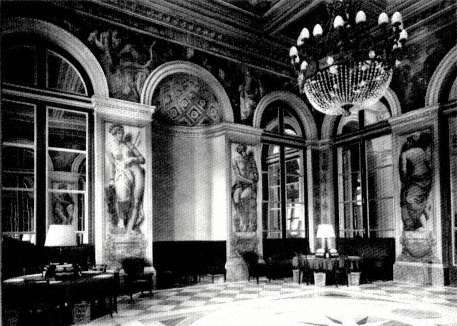
Fig. 47.
E. Delacroix, Salon du Roi, 1833-38. Palais-Bourbon, Paris.
and the principal waterways of France was appropriate to the monarch's function, as defined by article 13 of the charter:[18] "The king is the supreme chief of the state; he commands the forces of land and sea; declares war; makes treaties of peace, alliance, and commerce; . . . and makes the regulations and ordinances necessary for the execution of the laws."
Like Jacquot's colossal statue in the adjacent Salle Louis-Philippe (see Fig. 42), Delacroix's murals in the Salon du Roi represent a survival of the Napoleonic and Restoration association of law with the person of the ruler. The mural decoration above the throne niche—the first part visible, according to the artist, to someone entering the room—is devoted to the theme of justice.[19] This arrangement serves as a reminder that the Bourbon doctrine that "all justice emanates from the king" (Charter of 1814, art. 57) was preserved in the Charter of 1830 (art. 48).[20] The
sympathetic critic Louis de Ronchaud noted that "M. Delacroix has indicated justice as the foremost of royal virtues."[21] Reference to the monarch is also made on the ceiling above the throne where, as the critic Gustave Planche noticed, a personification of Justice holds a scepter rather than the traditional scales.[22]
The Salon du Roi iconography reflected an element of Old Regime doctrine shared by the constitutional Bourbon and Orléans monarchies, and its regal flavor suited the monarch's preeminence in the legislative process. "Legislative power," according to article 14 of the charter, "is exercised collectively by the king, the Chamber of Peers, and the Chamber of Deputies." Each entity could initiate legislation, with tax legislation subject to prior vote by the deputies (art. 15); and, in marked contrast to Napoleonic parliamentary practice, each law was to be "freely discussed and voted for by the majority of each of the two chambers" (art. 16). But only the "inviolable and sacred" king—who held all executive power (art. 12)—could sanction and promulgate laws (art. 18). Concealed within the bourgeois hat and umbrella of the Citizen King, one of the regime's wittiest critics suggested, were the crown and scepter of absolute monarchy.[23]
In light of the continuity between the charters of 1814 and 1830 (the Orléans charter was, after all, based on that of the Bourbons), it is fitting that Delacroix's representation of Justice in the Salon du Roi quietly alludes to the association between law and divine inspiration that had been evident in the paintings for the Council of State (Delacroix had contributed the evangelical Justinian to that Bourbon decorative cycle). And it was appropriate for the critic Gustave Planche to compare the bulky legislator, seated in the frieze above the throne, to the Sistine prophets.[24] This thematic orientation also suggests why the artist might have modeled Prudence, to the left of this figure, on Raphael's sibyls in Santa Maria della Pace,[25] and why the bearded head closest to Force resembles that of Michelangelo's Moses (Fig. 48).[26]
Across the Seine from the Palais-Bourbon, the theme of divine legislation was treated in the colossal bronze doors that Triqueti, assisted by Etienne-Hippolyte Maindron (1801-1884), sculpted for the Church of the Madeleine (Fig. 49). Commissioned by the government in 1834 and emplaced in 1841, the doors illustrate the Ten Commandments through biblical narrative.[27]
Originally the subject of the doors was to have been the life of the patron saint of the church, Mary Magdalen; the modification of the program reflects the political agenda of Louis-Philippe's constitutional monarchy. In dedicating the church
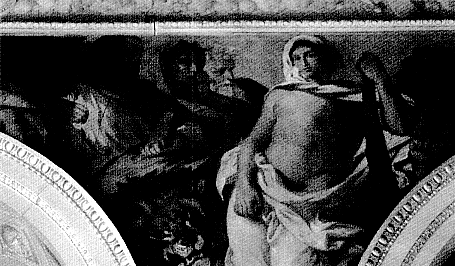
Fig. 48.
E. Delacroix, Justice frieze (detail), Salon du Roi, 1833-38. Palais-Bourbon, Paris.
to a penitent saint, the Bourbon Restoration referred to the nation's crimes during the Revolution, for in front of the church—in what is now the Place de la Concorde—Louis XVI had died on the guillotine.[28] The dedication suggests that the church was to have had a symbolic function similar to that of the Expiatory Chapel. Despite the commitment of the July Monarchy to ecclesiastical patronage, this expiatory reference to the Revolution had no place in its official art. On the contrary, the new regime aligned itself with popular sentiment as it focused on the nation's revolutionary and imperial past. Thus it publicized Louis-Philippe's military service during the Revolution and ceremonially returned the ashes of Napoleon to France in 1840.[29] Whereas Charles X had dedicated the square to Louis XVI and intended a statue of that king's apotheosis for its center, the July Monarchy—in a spirit of reconciliation—preferred a neutral obelisk and the name Place de la Concorde.[30] Inside the Madeleine, the Restoration plan for an altar sculpture of Mary Magdalen as a symbol of penitent France was not realized; instead, Carlo Marochetti sculpted Mary Magdalen Exalted by Angels (1834-41), and Jules-Claude Ziégler's painting The History of Christianity in the
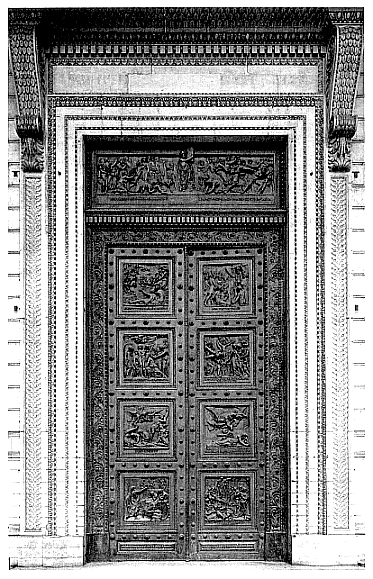
Fig. 49.
H. de Triqueti, The Ten Commandments , 1834-41. Paris, Madeleine.
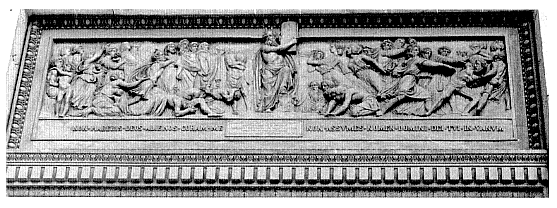
Fig. 50.
H. de Triqueti, Proscription of Idolatry and Blasphemy , 1834-41. Paris, Madeleine.
hemicycle (1837) represented the saint amid a historical, religious, and literary multitude that prominently includes Napoleon.[31]
Although there is little documentary evidence for the choice of subject for the Madeleine doors,[32] Adolphe Thiers, the minister in charge of the commission, shared a taste for Old Testament subjects with the Protestant Triqueti,[33] and the sculptor had employed the motif of the Mosaic tablets in his work in progress for the Salle Louis-Philippe, also commissioned by Thiers's ministry. This theme was especially suitable for a regime that looked to the law for its principal support.
The reliefs of the Madeleine doors are predominantly devoted to crime and punishment. The most solemn narratives employ a vehement emotional rhetoric absent from Triqueti's principal point of reference, the Gates of Paradise of Ghiberti—a work Thiers especially admired. Here are stern demonstrations of the "law of fear and terror," as Jewish legislation was characterized in a popular religious digest.[34] On the lintel (Fig. 50), the first two commandments (the proscription of idolatry and blasphemy) are represented by such emphatic demonstrations of anger and fear that a critic writing in L'Artiste mistakenly identified the subject as the Last Judgment .[35] At the center, a crowd of Hebrews prostrate themselves before Moses and the law with exaggerated awe. To the right, a bound criminal is hounded by accusers and dragged away for punishment.
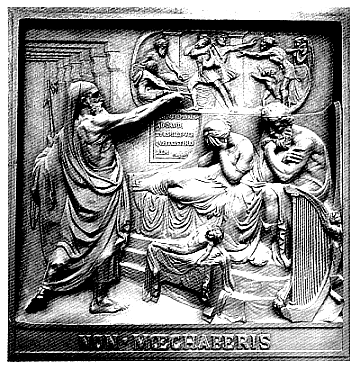
Fig. 51.
H. de Triqueti, The Crime of Adultery (The Prophet
Nathan Confronts King David) , 1837. Paris, Madeleine.
A similar severity characterizes the bottom panel on the left door, representing the crime of adultery (Fig. 51). Here Triqueti condensed the aftermath of King David's seduction of Bathsheba, the wife of Uriah the Hittite (2 Samuel 12). David, seated beside Bathsheba, is overcome with remorse as the stern prophet Nathan confronts him. Nathan reveals David's crime through the parable of a rich man who steals a poor man's only lamb, narrated in a subsidiary zone. As a sign of divine wrath, David's illegitimate son lies lifeless before his guilty parents.
The prohibition against coveting a neighbor's property is represented by a solemn exemplar of retribution in the bottom panel of the right door (Fig. 52). King Ahab and Jezebel flee before the indignant Elijah, who predicts that dogs
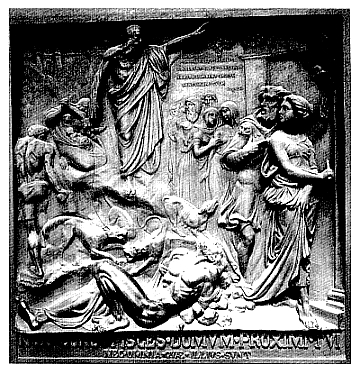
Fig. 52.
H. de Triqueti, The Crime of Coveting a Neighbor's Property
(Ahab and Jezebel Condemned by Elijah for the Murder of Naboth) ,
1837. Paris, Madeleine.
will lick the wicked king's blood and devour his guilty wife for coveting the vineyard of the murdered Naboth (1 Kings 21).[36]
The righteous anger with which Triqueti's bronze doors proclaimed the law of Moses reflected the young government's preoccupation with law and order as insurrection and subversion assailed it. Triqueti's patron Thiers was in the vanguard of the government's legal counter-offensive, and in the wake of a spectacular—and almost successful—attempt to assassinate Louis-Philippe in 1835, he championed the repressive September Laws that gagged the satirical press.[37] The righteous anger expressed in Triqueti's biblical narratives was matched by that of Duke Victor de Broglie, minister of foreign affairs, in a speech to the legislature
favoring the passage of the September Laws. He extolled the regime's legal war against its enemies, in a speech that drew cries of "Bravo!" from the chamber:
Rebellion . . . took to the streets; you have seen it knock on the doors of the king's palace . . . bare-armed, in rags, howling, uttering insults and threats, and thinking that it would prevail by fear. We have faced it; the law in hand . . . we have dissolved the anarchist organizations; we have arrested the leaders, scattered the soldiers . . . several times we have dragged it, in spite of its clamors, to the feet of justice, to receive its punishment.[38]
Commissioned by a government flattered by the association of its constitutional charter with the tablets of Moses, the Madeleine doors, with their stern imagery, constitute a resonant analogy to the regime's militant defense of the Charter of 1830.
The political significance of the Madeleine doors is amplified by their position in a large urban scheme commenced under Louis XV and completed during the July Monarchy (Fig. 53). A direct axis across the Place de la Concorde and the Seine links the Napoleonic porticoes of the Madeleine and the Palais-Bourbon (designated Corps législatif on the map, which dates from the Second Empire). This axis was bisected by another connecting the Tuileries palace (the residence of Louis-Philippe, destroyed during the Commune, at the west end of the Louvre) with the Arc de Triomphe de l'Etoile—the memorial to Napoleonic military glory completed under the July Monarchy. As an ensemble, the Palais-Bourbon, the Madeleine, the Tuileries, and the Arc de Triomphe formed a cross at whose center was the Place de la Concorde, site of the execution of Louis XVI.[39] The emotional charge of this central Parisian space was evocatively described by the ecclesiastical orator Lacordaire:
When the foreigner descends the river that divides Paris, he encounters a square whose breadth and monuments invite his meditation. On one side there is the palace of the kings of France, and facing him, at the end of a long avenue, is a military arch of triumph. In a second perspective, which cuts the first in the form of a cross, two temples correspond to each other: one is that of laws, the other that of God. In the center rises an Egyptian obelisk, which disappears under an invisible monument present to all minds, the scaffold of Louis XVI. All of France is on this square: royalty, military glory, liberty, religion, revolution.[40]
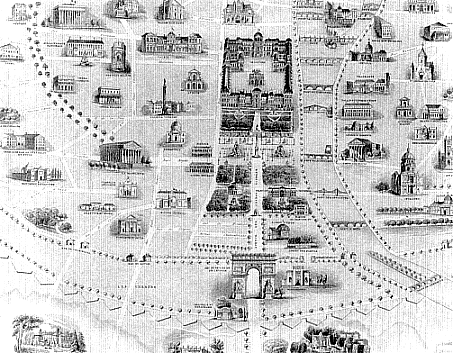
Fig. 53.
Place de la Concorde and environs, Paris (from the west; detail).
From Paris monumental et ses environs , Paris, n.d. Boston Public Library.
The correspondence between the Madeleine and the Palais-Bourbon united the divine law of Moses with the legal foundation of the regime.[41]
Two cartoons published in La Caricature subverted the exalted official discourse of legitimacy and legality expressed in Triqueti's relief sculptures for the Palais-Bourbon and the Madeleine. In the April 2, 1835, issue Benjamin (Benjamin Roubaud, 1811-1847) satirized the government's devastating campaign of lawsuits against the opposition press in "The New Moses" (Fig. 54). Jean-Charles Persil, the minister of justice, is Moses striking the rock, labeled "liberty
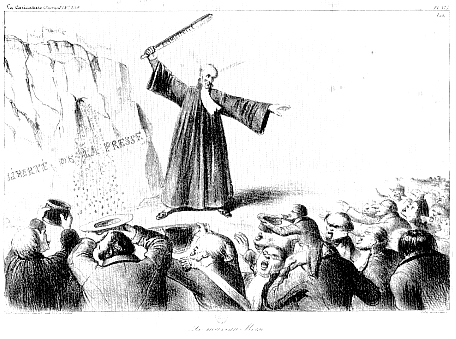
Fig. 54.
Benjamin, "The New Moses." La Caricature ,
April 2, 1835. Bibliothèque Nationale, Paris.
of the press," to produce water in the desert. The names of opposition papers appear on banners atop the rock. Persil's cudgel is labeled "requisitoire" (indictment); from the rock he has struck with it pours money, greedily gathered by members of the government as well as by Louis-Philippe, recognizable to readers of La Caricature by his misshapen head and mutton chops.[42]
Traviès (Charles-Joseph Traviès de Villers, 1804-1859) burlesqued biblical imagery in his "Adoration of the Golden Calf," published in the May 8, 1834, issue of La Caricature (Fig. 55).[43] Here Louis-Philippe's supporters are the idolatrous Hebrews who worshiped the golden calf while Moses received the divine law on Mount Sinai. These sycophants grovel before a pile of money bags labeled with examples of the regime's avarice (sinecures, secret funds, ministerial salaries) and topped by a giant radiant coin whose portrait in profile resembles that of
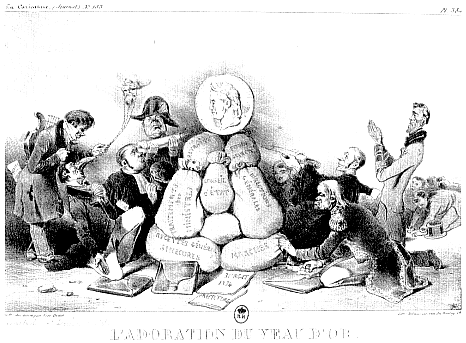
Fig. 55.
Traviès, "The Adoration of the Golden Calf." La Caricature ,
May 8, 1834. Bibliothèque Nationale, Paris.
Louis-Philippe on the five-franc piece used during the July Monarchy.[44] Persil, mocked as Père-Scie (Father Saw),[45] presents his toothy attribute like a saint in a sacra conversazione . A final insult is the resemblance of the pyramid of money sacks to the bloated and grimacing features of Louis-Philippe.
"The Adoration of the Golden Calf" and "The New Moses" belong to the genre anathematized by Lamartine in an address to the chamber, August 21, 1835, as "atrocious and seditious caricature, in which perversity of the heart toys with crime and scoffs at the holy images of fatherland and religion."[46] The schematic didacticism and encoded topical references of these caricatures make them negative counterparts to the flat-footed official allegory of Blondel and Mauzaisse in the Council of State paintings and, under the July Monarchy, of such works as Picot's July 1830: France Defends the Charter .
A more complex example of dissident art from the early July Monarchy is the large relief sculpture Tuerie by Auguste Préault (Fig. 56). Its thematic violence and stylistic daring shocked conventional taste at the Salon of 1834, one of whose visitors characterized the work as an "incredible farrago of every horror, wretchedness, misery, extravagance, monstrosity."[47] According to a famous anecdote, Tuerie was admitted to the Salon of 1834 solely at the insistence of the academician Jean-Pierre Cortot, who wanted it shown as a warning—like a criminal on a gibbet.[48]
No particular narrative is associated with the work, elusively described in the 1834 Salon livret as a "fragment épisodique d'un grand bas-relief."[49]Tuerie's subject, as indicated by the laconic title, is slaughter itself, apparently gratuitous. Hugh Honour said of it, "There are visual reminiscences in it. . .. But there is no programme. . . . Its subject has never been satisfactorily explained, and it was perhaps conceived simply as a scene of violence."[50] David Mower has compared the work to a composite of passages from Auguste Barbier and Sir Walter Scott,[51] but this analogy locates the sculpture only in a general context: the Romantic taste for passion and violence. Jacques de Caso, by pointing out that other sculptors of the time deployed similar thematic violence and extravagant irregularity of relief, has made Tuerie seem less of an anomaly, but no less original.[52]
Although this evocative and idiosyncratic work resists identification with any single source, the visual evidence suggests that Henri de Triqueti's Law reliefs in the Salle Louis-Philippe contributed to its conception. Préault's transformation of this source was guided by a pessimistic impulse to repudiate Triqueti's glorification of the civilizing force of law.
There are sufficient figural similarities between Tuerie and Avenging Law (see Fig. 44) to suggest that Préault (1809-1879), who exhibited the plaster version of Tuerie in the Salon of 1834, was familiar with Triqueti's Law reliefs, commissioned the previous year. Principal among these is the resemblance of the hysterical mother at the center of Tuerie to the female victim at the right of Avenging Law who, with hair streaming behind, wildly seeks the protection of a winged avenger. In addition, the fury of Triqueti's sword-bearing avenger is echoed in a male profile in the upper right corner of Tuerie ; the bearded thief on the left side of Avenging Law offers a conventional point of departure for the extravagantly grimacing African head that is desperately repulsed with both hands by a swooning long-haired woman in the upper left corner of Tuerie ; and the baby in Tuerie seems an unfortunate cousin of the doughy-limbed child that lies at its mother's
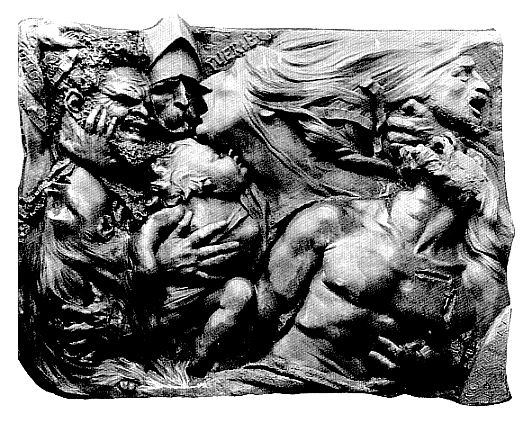
Fig. 56.
A.-A. Préault, Tuerie (Slaughter), 1834. Chartres, Musée des Beaux-Arts.
breast in Protecting Law (see Fig. 43). The startling scale of Tuerie , somewhat larger than life, recalls that of Triqueti's allegorical reliefs; the architect and critic Gabriel Laviron praised Tuerie's suitability for an architectural setting—a quality that set it apart from the other sculpture at the Salon.[53] Particularly suggestive is Préault's placement of the word TUERIE in a position similar to that of the inscription LEX on the Mosaic tablets in Triqueti's reliefs. The inscriptions underscore the disparity between Triqueti's celebration of order, justice, and civilization under the aegis of law and Préault's evocation of blind, chaotic slaughter.
That Préault could have been spurred by a desire to negate Triqueti's Law reliefs squares with the record of his notoriously caustic wit, characteristically directed against authority and established taste.[54] Préault said he detested "consecrated platitudes."[55] The myth that law nurtured civilization smacked of hypocrisy in light of the terrible events of the early July Monarchy. The escalating rhythm of insurrection and repression of these years led, shortly after the opening of the Salon of 1834, to the Rue Transnonain Massacre (April 14, 1834).[56] French sympathy had been deeply stirred by Russia's brutal subjugation of Poland in 1831. And in the spring of 1832 more than eighteen thousand Parisians perished during a cholera plague, in a climate of mass hysteria.[57] Considered in relation to Triqueti's official allegories, the fragmented Tuerie resonates with the force characteristic of the sculptor's conversation. According to Théophile Silvestre, "Préault never thoroughly develops an argument but runs and flies after violent or refined images and comparisons. He also proceeds by ironic negations and imperious affirmations, reinforced by sarcasm and nervous laughter in the modern manner."[58]
Unlike Triqueti's reassuring allegories, Tuerie has formal audacity as well as aggressive content. Symmetry gives stability and regularity to both the spirited Avenging Law and the serene Protecting Law , both of which uphold French sculptural tradition in their strict and elegant conformity to the wall plane. Tuerie , on the contrary, has neither groundline nor symmetry; and the emphatically planar composition emphasizes the suffocating compaction of the wracked bodies. This sense of claustrophobia is intensified by the uncomfortable proximity of several gaping mouths. The anatomical forms bulge so extravagantly that several pas-sages—notably the dying man in the lòwer right—seem to have been conceived in the round rather than in relief.
Tuerie and the Law reliefs are as different as the social and professional positions of the two sculptors. Triqueti was the son of Baron Michel de Triqueti, a Piedmontese industrialist who had served as the ambassador of Sardinia to Russia before the Revolution; Préault's father was a Parisian metalworker. Préault, notorious as a pugnacious cultural dissident, was frequently rejected by the Salon juries of the July Monarchy; the independently wealthy and amiable Triqueti enjoyed both respectability and royal favor.[59]
The subversiveness of Tuerie resembles that of a disturbing voice in contemporary French literature, Pétrus Borel (1809-1859). Préault's exact contemporary, Borel was the most outrageous member of a rebellious literary and artistic circle,
the Jeunes-France , that included Théophile Gautier, Gérard de Nerval, and Pré-ault's friend Célestin Nanteuil.[60] Préault aided Borel and his group in their famous attack on academic propriety at the premiere of Hugo's Hernani , February 25, 1830; and Préault has been identified as the "jeune sculpteur de beaucoup d'esprit et de talent"[61] who shouted at the elder members of the audience, "A la guillotine, les genoux!" (Guillotine the baldpates!).[62] The year before the exhibition of Tuerie , Borel wrote appreciatively of Préault's works in the Salon of 1833; impressed by the focus on suffering in Two Poor Women and Beggary , Borel praised the sculptor as one of the few who realized that the Romantic revolution in art was a moral issue, not one that called simply for a new literary subject matter.[63] Borel's Champavert, contes immoraux , published in 1833, resembles Tuerie in its violence.
This sadistic narrative, filled with suicide, murder, and rape, could be as brutally abrupt as Tuerie . The title story of the collection, "Champavert, le lycanthrope" (i.e., Champavert the wolfman), furiously maligns law and justice. Prior to committing suicide, Champavert goes with his lover to the grave of their illegitimate child, murdered in childbirth. He exhumes the skeleton, which he brandishes and flings away, indicting the laws that Triqueti was celebrating in the same year in the Palais-Bourbon:
Law! virtue! honor! you are satisfied; here, take back your prey! . . . Barbaric world, you wanted it, here, look, it is your work, yours. Are you content with your victim? . . . Bastard! it's quite shameless of you to have wanted to be born without royal authorization, without a wedding announcement! Eh! law? eh! honor? . . . Barbaric law! ferocious prejudice! infamous honor! men! society! here! take your prey! . . . I surrender it to you!!![64]
An earlier passage from the same story offers yet another point of comparison to Tuerie in its frenetic enumeration of horrors. Champavert denounces as a lie the idealization of love:
Let them come forth, the impostors, so that I can strangle them! the knaves who sing of love, who garland it and pipe it, who make it a chubby child, chubby with joys, let them come forth, the impostors, so that I can strangle them! To sing of love! . . . for me, love is hate, groans, cries, shame, mourning, iron, tears, blood, cadavers, bones, remorse; I have known no other! . . . Go ahead, rosy shepherds, sing of love, derision! bitter masquerade![65]
Gabriel Laviron, who admired Tuerie and whose portrait Préault exhibited in the Salon of 1833, wrote a sympathetic review of Champavert, contes immoraux . Praising the truth of the passions, murders, and "desolate philosophy" of the book, Laviron welcomed Borel's ruthless unmasking of public complacency and parodied the false smugness of offended readers in a list of recent horrors whose bitter irony foreshadows Tuerie :
Why always horror, cadavers, bloody vicissitudes? decent folk will repeat; they have no place in our era, which is so calm, so uniform; because civilization, enlightenment. . .. From time to time there is some shooting under our windows . . . barricades, the dead that one walks on; another time, men that the crowd tears into pieces: last summer, cadavers that they piled into wagons like corded wood. . .. But since yesterday who gives any of that a thought, and what do you want from us with your gravedigger literature?[66]
Like Borel's contemporaneous writing, Tuerie embodies an implacable hostility to the middle-class ideals, values, and taste of the July Monarchy. The writer and sculptor are alike, moreover, in the distance of their revolutionary posturing from any concrete political engagement. Paul Bénichou has shown that political activism was foreign to Borel and his rebellious circle.[67] There is no documentation of Préault's political activity apart from the allegation after his death that he had "lifted two or three paving stones when barricades were raised against Charles X."[68]
Although Tuerie can be viewed as a negative counterpart to Triqueti's allegories in the Salle Louis-Philippe, its subversiveness remains implicit. Préault's sculpture lacks the black humor, the schematic didacticism, and the topical reference of contemporary images published in La Caricature . Unlike parody, with its constant and outspoken reference to the subverted prototype, Tuerie incorporates only traces of Triqueti's imagery, subsuming them in a melodrama whose anatomical truncations both amplify the emotional charge of the theme and reinforce the grandiose suggestion of a preserved fragment. Préault's avoidance of iconographic specificity—together with the broad modeling and the inclusion of the abstract title and medieval helmet—gives this massacre an evocative scope greater than that of Triqueti's official idealism, of La Caricatures defamatory brutality, and of
Borel's gruesome exclamations. At the same time, comparison between Tuerie and Triqueti's Law reliefs suggests the inspirational force of rage in the dark period around 1834, when a scandalous discrepancy was perceived between official rhetoric and political reality.